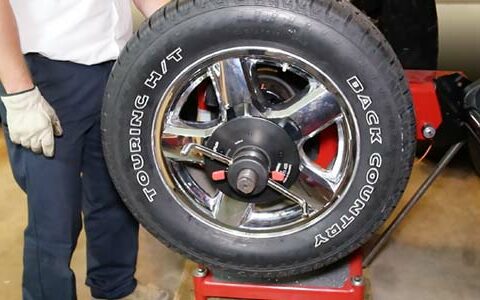When you own a car, you must take care of it to keep it running smoothly and safely. You should regularly check the oil and other fluids, change the oil when necessary, rotate the tires, get maintenance checks, know if you need new tires etc. All these things are essential for keeping your car in top shape to last a long time.
Even though you might not think about your car’s tires very often, they impact how your car drives and how much fuel it uses. When your vehicle has the correct tire pressure, it will operate more efficiently and use less gas.
This article covers everything you need to know about rotating your tires and how often you should do this to keep them in excellent condition.
What Does Rotating Tires Mean?
You change your tires when you rotate them, so all tires are used equally. By doing this, your tires will last longer because they will be less likely to wear unevenly.
You can use larger tires on all four wheels if you own an SUV. If you own a sports car, you might want to use smaller tires to get better gas mileage. You can travel more easily over rough terrain this way.
You need to rotate your tires regularly to keep them in good condition. Vibrations and bumps in the road can cause them to wear out more quickly. However, there are more reasons for tires to wear out. And these may cause your car to get lower gas mileage, and your car would produce more carbon emissions.
Why Are Rotating Tires So Important?
When you rotate your tires, you prevent them from wearing unevenly. The outside of each tire will wear more quickly since it travels over dirt, rocks, and other debris. The inside of each tire travels over smooth asphalt and will be less worn. When you rotate them, you won’t need to replace your tires as often.
If you don’t rotate your tires, you are more likely to get a flat tire. Your car travels over rocks, sand, and other debris because a new, worn tire is attached to the part that travels over them. This tire will quickly become flat, and you won’t know what caused the flat tire until you take it off and inspect the inside. When you rotate your tires, they are all equally worn, so you can immediately see what caused the flat tire. Then you need to get your flat tire repairs quickly.
How Often Should You Rotate Tires?
You should rotate your tires every 6,000 to 10,000 miles. If you drive a lot, you should do this every six months to a year. It is a good idea to mark on your calendar when you last rotate your tires so that you don’t forget to do it again.
If you drive on primarily smooth pavement, you don’t need to turn your tires often. You need to rotate your tires more often if you drive off-road. You may want to rotate your tires every 3,000 miles if you go through mud or other rough terrains.
Tire Rotation Patterns
Your car may have a specific rotation pattern on the tire sticker. If it doesn’t, you can use the following table: If you own two vehicles with tires of different sizes, you should rotate the tires of each one every 6,000 miles. This way, both cars will wear evenly.
If you only own one car with tires of different sizes, you can rotate the tires of one car every 6,000 miles. The other vehicle will wear more unevenly since it won’t have any other tire to turn with.
Here are some of the more common tire rotation patterns you can try:
Rotating Non-directional Tires
Three main rotation patterns can be used for vehicles of the same size and offset on the front and rear: Forward Cross, X-Pattern, and Rearward Cross.
- Forward Cross: This pattern is used for front-wheel drive vehicles. Rear tires move opposite sides of the front axle, while front tires move straight back.
- X-Pattern: This alternate pattern to the Forward Cross for front-wheel drive vehicles. A front tire moves to a back tire, and a back tire moves to a front tire.
- Rearward Cross: Typically, rear-drive or four-wheel drive vehicles use this pattern. Tires on the rear move straight up, while tires on the front move backward.
Rotating Directional & High-Performance Tires
Aside from the three main rotation patterns listed above, you can rotate today’s high-performance tires and wheels in two different ways.
- Front-to-back: A directional tire’s tread pattern ensures it rotates in the same direction from front to back. It is only recommended to rotate directional tires from front to back (or vice versa) on the same side as the vehicle. In vehicles with the same size and offset directional tires, the front tires move to the rear axle on the same side, and the rear tires move to the front axle on the same side.
- Side-to-side: If your vehicle has different-sized, non-directional tires on the front and rear axles, it will use a side-to-side pattern. Front and rear axle tires move to opposite sides. Having different-sized directional tires on the front and rear of your vehicle will require dismounting the tires, remounting, and balancing on the opposite wheels.
Rotating With Full-size, Non-directional Spare Tires
A four-wheel drive or all-wheel drive vehicle’s spare tire might place excessive force on the drive train if it has a different tread depth than your other three tires. That’s why it’s essential to check your owner’s manual to see if the manufacturer recommends a tire rotation pattern; if so, follow it.
To keep all five tires even, you might want to consider these rotation patterns. Do note that these work if your spare tire is full-size, non-directional, and doesn’t say “temporary.”
- Forward cross for front-wheel drive: You can use this pattern if you have non-directional tires with a full-size matching spare on your front-wheel drive vehicle. The rear tires go to the left rear, and the right front tire becomes the extra.
- Rearward cross for rear-wheel drive or 4-wheel drive: Alternatively, you can use this pattern if your vehicle is rear-wheel drive or 4-wheel drive with non-directional tires. The left rear tire is shifted to the left front. Move the right rear tire to the right front. The spare tire on the right rear becomes the spare tire on the left front.
Conclusion
Rotating your tires properly will help them last longer and handle better so that you don’t get a flat tire. Rotating your tires when they reach about 6,000 miles helps to even out their wear patterns and extends their useful life. You also reduce the risk of skidding or losing control of your car on wet or icy roads.
Are you looking for tire rotating services, rim repairs, and other tire-related work? Schedule your appointment today here at Tire Butler!




